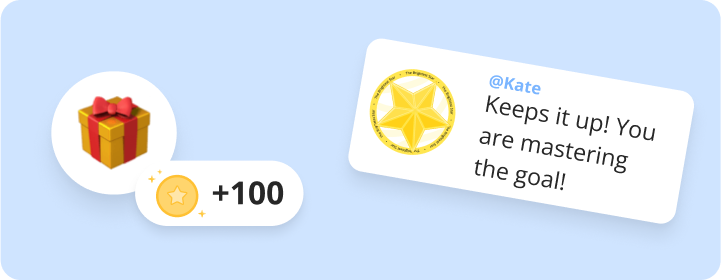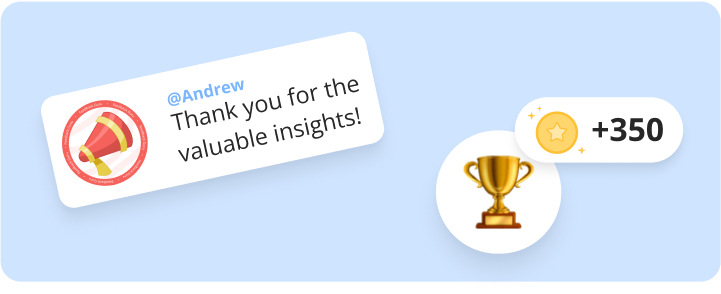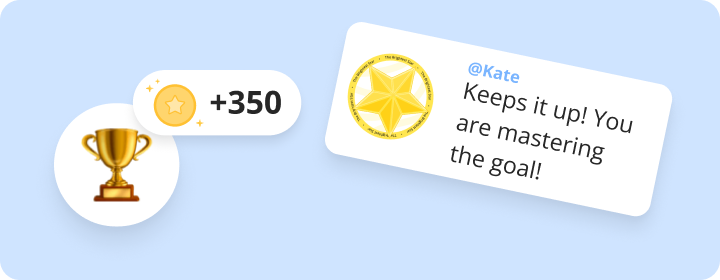10 Ways to Improve HR Change Management & Help Employees Adjust
Whether it's a new system, leadership shift, or policy update, how change is managed can make all the difference.
In this article, we'll explore ten practical ways to improve HR change management and help employees feel supported, informed, and ready to adapt.
Why HR Change Management Matters in 2025
Did you know that 70% of change programs fail to achieve their goals?
The main reason behind these failures?
Employee resistance and lack of management support.
But this is nothing new — employees have long been wary of change.
However, in 2025, we're seeing a faster pace of change than ever.
These days, companies are dealing with constant changes, which necessitate the development and adoption of new tech, new policies, and new processes.
What's more, with remote working now so common, many companies now face extra obstacles around the implementation of change programs.
Remote employees often feel more disconnected from their employer than they would if they were in the office daily, impacting trust, engagement and morale.
If you're working in an office going through a transition period, you're likely to see physical changes.
For example, you might see teams being rearranged onto different desks or new tech being brought in to replace old gadgets.
Furthermore, remote training is often less effective than in-person sessions, and it's harder for managers to check whether their team members are genuinely adopting new tech, processes, or policies.
HR has a strategic role in bridging this engagement gap.
Indeed, it plays a vital role in keeping employees engaged during change by communicating openly, involving teams in the process, and recognizing their efforts.
They create a supportive environment through feedback channels, training, and consistent updates — helping employees feel valued, heard, and connected, even when they work remotely or things are shifting around them.
What Is Change Management in HR?
HR and change management and change management go hand in hand.
After all, people must be at the heart of any change management strategy.
And, indeed, the role of HR in change management is all about helping people navigate change smoothly within an organization.
It involves guiding employees through transitions — whether it's a policy update, security training, CRM migration, or restructuring — by communicating, offering support, and minimizing disruption.
Indeed, when it comes to change management, HR is generally responsible for communication, enablement, and adoption.
Think planning, engaging stakeholders, managing resistance, and ensuring changes stick.
It's not just about the processes but the people — how they feel, adapt, and thrive.
And no one understands people like HR teams.
They are well placed to design people-centred transitions, avoiding top-down mandates that are doomed to alienate employees and subsequently fail.
For months, and potentially even years, before the change is even conceived of, HR teams should be working to build trust and culture around adaptability.
Ultimately, HR change management makes change less daunting and more successful by keeping the human element front and center.
What are the key outcomes of successful HR involvement?
You're aiming for faster transitions, improved morale, and higher levels of participation.
🚀Find out how HR teams can use Esteeme to support change emotionally, not just operationally.
10 HR Change Management Strategies That Actually Work
HR involvement in change management is, of course, absolutely crucial to success.
But that doesn't mean it's easy.
Indeed, implementing change is, by its very nature, challenging, but the right strategies make all the difference.
When executed well, the ten proven change management for HR techniques below can help leaders navigate transitions smoothly, boost employee engagement, and drive long-term success.
⬇️ Read on to discover practical, effective approaches to manage change and strengthen your organization from the inside out.

#1 Communicate Early, Often, and Transparently
Effective communication is the cornerstone of successful change management.
HR professionals must communicate early to prepare employees for what's ahead, reducing uncertainty and resistance.
In some circumstances, you can even start your communication campaign before the big announcement by building excitement around upcoming changes.
When providing initial employee communications, you can use Esteeme background teasers like "something new is coming" to build buzz.
Then, frequent updates will help to maintain momentum, keeping everyone aligned and engaged throughout the process.
Remember — transparency builds trust.
After all, when employees understand the reasons behind changes and how decisions are made, they're more likely to support them.
Clear, honest communication also opens the door for feedback, allowing HR to address concerns and adjust strategies in real-time.
In short, early, frequent, and transparent communication empowers employees and creates a culture of collaboration during times of transition.
But it's not just about when you communicate; it's also about how.
HR teams must announce changes with clarity and explain the "why".
If you share the authentic reasons behind decisions, employees are much more likely to understand why they need to adapt to changes that they may not want to.
#2 Segment Messaging by Audience

One-size-fits-all rarely works when it comes to internal comms.
This is because different employee groups experience change in unique ways.
A change could impact your IT department in a completely different way than your sales team, so they're likely to have other questions and reactions to the news, too.
On a similar note, you might want to give management more in-depth information about the change than more junior employees.
The solution?
Tailor your messages to each audience.
Segmenting communication ensures that information is relevant, understandable, and meaningful to specific roles, departments, or leadership levels.
This targeted approach increases clarity, reduces confusion, and addresses the distinct concerns of each group.
By aligning messaging with audience needs, HR can foster greater buy-in, improve engagement, and ensure a smoother transition across all parts of the organization during change initiatives.
Segmentation can be time-consuming if you don't have the right tools to support you.
For example, bulk email systems like MailChimp can help you segment your email list and automate sending.
Meanwhile, if you're an Esteeme user, you can tap into its events or visual features to tailor messaging across teams.
#3 Involve Employees in the Process

Want to reduce resistance to change within your organization?
Then, it's crucial to involve employees in the change management process.
When people feel heard and valued, they are more likely to support and champion new initiatives.
HR can engage employees through:
💡Focus groups
💡Feedback sessions
💡Pre-launch pilot programs
💡Idea boards on Esteeme
💡Polls on Esteeme
In other words, you need to give employees a platform to share insights and voice concerns.
Taking a collaborative approach not only surfaces valuable ideas and gives employees a sense of ownership over the change management process but also strengthens trust and transparency.
Indeed, by making employees active participants rather than passive recipients, HR can build stronger commitment and ensure smoother, more effective implementation of change throughout the organization.
#4 Recognize Change Champions

During times of organizational transition, change champions are your best friends.
These are the early adopters, informal leaders, and peer advocates who help you push your change agenda forward, and this behaviour is certainly worth encouraging.
Indeed, recognizing change champions is essential for successful change management.
These individuals play a key role in influencing peers, modeling positive behavior, reinforcing the benefits of change, and helping to sustain progress long after the initial implementation phase ends.
After all, employees are often more likely to listen to their peers than their managers.
And by identifying and supporting these champions, HR can amplify the change message and create momentum across the organization.
Publicly acknowledging their contributions boosts morale, encourages others to get involved, and builds a culture that embraces transformation.
This recognition can come in many forms, from shoutouts in meetings and Esteeme badges (for example, a 'Migration Hero' badge) to leadership opportunities in the change process.
Esteeme also makes it easy to automate shoutouts and peer recognition, saving time while amplifying your impact.
#5 Turn the Change Into a Campaign

Esteeme's Events feature offers a structured approach to managing change within an organization by facilitating the creation of multi-step, event-based campaigns.
HR professionals can design a series of interconnected events — such as workshops, training sessions, and team challenges — that guide employees through the change process.
Each event can be aligned with specific company values and objectives, ensuring relevance and coherence.
Meanwhile, the platform's gamification elements, including badges and coins, motivate participation and engagement.
For example, you could offer a coin-based reward for each completed task, such as training, feedback, or testing.
These features enable organizations to systematically implement change, track employee involvement, and foster a culture that embraces transformation.
#6 Reward Completion of Training and New Processes

Attractive incentives are vital when it comes to reinforcing and encouraging positive behaviour.
Offering rewards for completing training and adopting new processes signals that the organization values effort and adaptability, boosting morale and participation.
It also shows that the business is heavily invested in the change in question, so employees should be too.
For example, you might offer rewards for tasks such as:
Task 1: Finish cybersecurity module — 15 coins
Task 2: Screenshot proof of updated profile — 10 coins
Task 3: Share thoughts on the new tool — 5 coins
Employees can then redeem these coins for tangible rewards in Esteeme's online gift store.
You can also sweeten the deal by handing out Esteeme badges — which team members can proudly display on their profile — for the completion of specific tasks.
Recognition — whether through incentives, shoutouts, or badges — helps build momentum and makes the change feel more rewarding.
Ultimately, this approach encourages quicker adoption, increases retention of new practices, and strengthens a culture of continuous improvement.
#7 Train Managers to Support Their Teams
Training managers to support their teams during change management is crucial for ensuring a smooth transition.
Managers are the front-line leaders who directly influence employee engagement and morale.
When trained and handed key resources, they can effectively communicate change, address concerns, and offer guidance, helping to alleviate stress and resistance.

Here are some valuable examples of change management in HR when it comes to equipping people managers:
✅ Change management training: Provide formal training that covers key concepts, strategies, and best practices in managing change.
✅ Communication skills development: Train managers to communicate change clearly and empathetically. This includes techniques for addressing concerns, delivering difficult messages, and maintaining transparency.
✅ Provide resources and tools: Equip managers with the right resources, such as change management toolkits, templates, communication guidelines, and talking points to help them navigate the process efficiently and consistently across teams.
✅ Run 'manager boot camp' events: Use Esteeme to run 'Manager Boot Camp' events, track each manager's progress, and ensure they have all completed the required tasks.
✅ Create support networks: Establish peer groups or mentoring relationships where managers can share experiences, challenges, and solutions.
✅ Scenario-based practice: Use role-playing or simulation exercises to help managers practice handling everyday change management situations, such as resistance or uncertainty.
#8 Boost Engagement Through Fun Activities
Boosting engagement through fun activities during a HR change management plan helps create a positive atmosphere, reduces stress, and keeps morale high.
Change can often feel overwhelming or uncertain, but incorporating enjoyable elements — like team-building games, themed challenges, or recognition events — adds energy and motivation to the process.

And with Esteeme, you can use coin incentives to encourage employees to participate in events and help to make the transition fun rather than frustrating.
These activities encourage collaboration, strengthen relationships, and help employees feel more connected to the organization's goals.
After all, when people are engaged and enjoying the journey, they're more open to embracing new systems and behaviors.
#9 Track Engagement & Course Adoption
In 2025, you need to be using analytics to make data-driven decisions.
Fail to track your results and act on the insights, and you face falling behind the competition.
Indeed, tracking engagement and course adoption during change management initiatives in HR is essential for measuring progress and identifying areas needing support.
By monitoring participation in training, feedback sessions, and new process adoption, HR can gain insights into how well the change is being received.
This data helps pinpoint resistance, adjust strategies, and provide targeted support where necessary.
It also allows for recognition of high performers and change champions.
Furthermore, tracking ensures accountability and demonstrates whether the organization is on track to meet its change objectives.
You can use Esteeme to monitor real-time completion data and adjust your change management HR strategy based on participation, feedback, and blockers.
#10 Celebrate Milestones and Close the Loop
Change is hard, so it's important to celebrate the wins along the way.
Acknowledging key achievements — like completing training phases or successfully adopting new tools — boosts morale, validates effort, and keeps teams motivated.

These celebrations could look like this:
🎁 Thank you messages from leadership
🎁 Bonus Esteeme badges
🎁 'Change Champion' awards
🎁 Team recognition events
🎁 Spotlight success stories
🎁 Esteeme coins that can be redeemed in the gift store
It's also important to "close the loop" by sharing outcomes, lessons learned, and next steps, which fosters transparency and trust.
These actions help employees feel their contributions matter and that the change is meaningful and well-managed.
By recognizing progress and providing closure, HR strengthens engagement, builds a culture of appreciation, and ensures a more cohesive and successful transition across the organization.
How Esteeme Solves the Change Adoption Problem
Change management is now more complex than ever, thanks to a rapidly changing business environment, shifting employee expectations, and the rise of remote working.

This means that, in many cases, traditional change management methods are no longer effective.
Gamified recognition platform Esteeme combines gamified campaigns with interactive communication to keep employees motivated.
It employs badges, interactive tasks, and redeemable coins to make change feel like progress.
With Esteeme, HR teams have plenty of super-engaging tools at their disposal, from custom visuals and meme badges to task-based events.
This makes it much easier to build momentum in the run-up to transitions and to keep employees motivated and engaged throughout the HR change management process.
Real-world examples like Room 8's Microsoft Teams migration
When Room 8 decided to migrate to Microsoft Teams, it turned to Esteeme.
The results looked like this.
3x increase in participation
10–15% boost in adoption
Employee satisfaction rose to 4.5 vs 3.9 in a previous, non-gamified rollout

Conclusion
Employee resistance is the number one barrier to effective change.
But HR can overcome it with the right blend of communication, recognition, and engagement.
It's a tricky balance to get right if you don't have the right tools.
So harness the power of Esteeme and make change management simple, structured, and motivating.
📈Book a demo today to see how Esteeme transforms change into progress
FAQs
- Change management is a structured approach HR takes to help employees adapt to organizational changes. HR's role in change management involves planning, communication, training, and support to ensure smooth transitions during mergers, restructuring, technology updates, or policy changes. The aim is to minimize resistance, increase uptake, and maintain productivity and morale.
- HR change management shows up during moments of transition. Change management examples in HR include: ➡️ Mergers ➡️ Leadership changes ➡️ Transition to remote work ➡️ Rolling out new HR systems ➡️ Updating policies ➡️ Launching diversity and inclusion programs These initiatives help teams adjust smoothly, stay informed, and feel supported throughout your change effort.
- HR plays a key role in guiding employees through change by keeping communication clear, offering training, and creating space for feedback. Through human resource management, these teams help ease uncertainty by being approachable, answering questions, and making sure everyone has what they need to adapt confidently. It's all about support, clarity, and a steady hand.
- Esteeme supports HR change management by enhancing employee engagement and recognition during transitions. Its gamified platform allows employees to earn badges and coins, empowering managers to motivate teams in the right direction and encouraging employee participation during times of change. Meanwhile, Esteeme's suite of culture-boosting tools allows you to link rewards to company values, reinforcing organizational principles amid change. Additionally, Esteeme's HR essentials kit helps you streamline time-off management and gives you a visual overview of organizational structure, which is extremely useful during transition periods.







